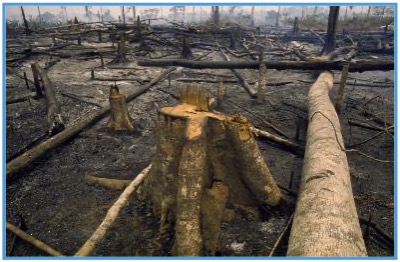In November 2021, the Global Carbon Project published its Global Carbon Budget 2021 which concluded:
-
The global average concentration of CO2 in the atmosphere increased from about 277 parts per million (ppm) in 1750 to 414 ppm in 2020 (up 49%)
-
In 2020, global CO2 emissions from fossil fuels were 34.8 GtCO2, a decrease of 5.4% from 36.7 GtCO2 in 2019.
-
For 2021, global CO2 emissions from fossil fuels are projected to grow 4.9% to 36.4 GtCO2, a level which is about 0.8% below the 2019 level. (The 2021 growth of 1.6 GtCO2 is similar to the growth observed in 2010 following the global financial crisis of 2008-2009: 1.7 GtCO2 or 5.5% above 2009 levels.)
Global fossil CO2 emissions in 2021 are set to rebound close to their pre-COVID levels after an unprecedented drop in 2020. Emissions from coal and gas use are set to grow more in 2021 than they fell in 2020, but emissions from oil use remain below 2019 levels.
The record decrease in 2020 emissions was 1.9 billion tonnes of CO2 (GtCO2) [-5.4%], from 36.7 GtCO2 in 2019 to 34.8 GtCO2 in 2020. Emissions are projected to grow 4.9% (4.1% to 5.7%) in 2021, to 36.4 GtCO2. Global emissions in 2021 remain about 0.8% below their level in 2019. The 2021 growth of 1.6 GtCO2 is similar to the growth observed in 2010 following the global financial crisis of 2008-2009 (1.7 GtCO2; 5.5% above 2009 levels).
Annual global CO2 emissions
Annual Global CO2 Emissions
(2011 - 2021)*
2021 Global Carbon Budget (November 2021)
1 Gigatonne (Gt) = 1 billion tonnes
|
|
Fossil |
Land Use Change (Gt) |
Total* (Gt) |
| 2021 | 36.4* | ||
| 2020 | 34.8 | 3.2 | 38.0 |
| 2019 | 36.7 | 3.8 | 40.5 |
| 2018 | 36.6 | 3.9 | 40.5 |
| 2017 | 35.9 | 3.7 | 39.6 |
| 2016 | 35.5 | 3.7 | 39.2 |
| 2015 | 35.5 | 4.8 | 40.3 |
| 2014 | 35.5 | 4.6 | 40.1 |
| 2013 | 35.3 |
4.3 | 39.6 |
| 2012 | 35.0 | 4.7 | 39.7 |
| 2011 | 34.5 | 4.8 | 39.3 |
Source data from Global Carbon Project 2021 (via ICOS):
data supplement + global data (.xlsx) + national emissions (.xlsx)
*NOTES: (1) Values for GtCO2 in the above table were calculated by CO2.Earth by multiplying carbon emissions in the linked Excel data file by 3.664, and by adding emissions from fossil fuels and land-use change to determine total emissions
(2) Fossil fuel emissions exclude sinks from cement carbonation
(3) Global fossil fuel emissions for 2021 are projected
Global carbon budget 2021
The data below summarize all human-caused sources of CO2 emissions and global sinks (where the CO2 goes). Numbers present the yearly average for one decade (2011 to 2020). Data were published November 5, 2021, in Global Carbon Budget 2021 by the Global Carbon Project.
Global CO2 emissions from human activity
Most human-caused emissions of CO2 into the atmosphere are from burning fossil fuels that had long been stored in the crust of the Earth. A small part of the fossil fuel total is from new cement usage.
 |
89% 34.8 GtCO2/yr
Fossil fuel emissions |
 |
11% 4.1 GtCO2/yr
Emissions from land use change(mostly deforestation) |
Where the CO2 emissions go
From 2011 to 2020, about 55% of global emissions were absorbed by the terrestrial biosphere and oceans. The remainder were added to the CO2 which is accumulating in the atmosphere. This accumulation has been observed as continued increases in CO2 concentrations in the atmosphere.
 |
48% 18.6 GtCO2/yr Atmosphere |
 |
29% 11.2 GtCO2/yr Vegetegation & Soils(terrestrial biosphere) |
 |
26% 10.2 GtCO2/yr Oceans(terrestrial biosphere) |
Balancing the Budget
The global carbon budget numbers above are the best available scientific determinations at the time they were reported. Scientists also report an imbalance of 3% (-1.0 GtCO2/yr) between the estimates for global sources and sinks. See the data description paper, Global Carbon Budget 2021, by Friedlingstein et al for information about the data reporting methods and uncertainties.
 |
3% -1.0 GtCO2/yr Imbalance(all sinks vs. all sources) |
|
About the Global Carbon ProjectThe Global Carbon Project and its partners provide annual scientific assessments of CO2 emissions from human activities and their redistribution in the atmosphere, ocean and terrestrial biosphere in a changing climate. The assessments support the understanding of the global carbon cycle, development of responses to the climate crisis and project climate changes ahead. Assessments and data from the GCP quantify the five major components of the global carbon budget: fossil CO2 emissions (including cement production); land-use change (mainly deforestation); ocean sinks, terrestrial sinks and atmospheric accumulation. These assessments also provide the best-available quantification of the imbalance between global emissions from human sources and changes in the atmosphere, ocean, and terrestrial biosphere.
|
Quick Links
Global Carbon Project (Nov 2021) Global carbon budget 2021
Carbon Brief (Nov 2021) Global CO2 emissions have been flat for a decade, new data reveals
IEA (Mar 2021) Global energy review: CO2 emissions in 2020
Carbon Monitor Latest CO2 emissions variation (updated monthly)
Climate Action Tracker (Oct 2021) Press release: Progress lags to limit emissions to 1.5 C but rapid change is possible
Climate Action Tracker (Oct 2021) State of climate action 2021 (report)
CO2 in Context (2020) Foley: 3 most important climate graphs [web]
GCP 2015 global carbon budget highlights (compact)
CDIAC Data for Global Carbon Project (all years) [2015 .xlxs]
CDIAC DATA: Global CO2 emissions 1751-2011 [files] [more]
ESSD Le Quéré et al. | Global Carbon Budget 2015 [.pdf]
ICOS web Links to all annual publications of the Global Carbon Project
UNEP Emissions Gap Reports
"The Emissions Gap Report 2021 shows that new national climate pledges combined with other mitigation measures put the world on track for a global temperature rise of 2.7°C by the end of the century. That is well above the goals of the Paris climate agreement and would lead to catastrophic changes in the Earth’s climate. To keep global warming below 1.5°C this century, the aspirational goal of the Paris Agreement, the world needs to halve annual greenhouse gas emissions in the next eight years."
--UNEP Emissions Gap Report 2021 (web: Oct 26 2021)
"Latest UNEP Emissions Gap Report finds new and updated Nationally Determined Contributions only take 7.5% off predicted 2030 emissions, while 55% is needed to meet the 1.5°C Paris goal."
--UNEP Press Release (web: Oct 26 2021)
UNEP web 2021 Emissions gap report
UNEP pdf Download full report: 2021 Emissions gap report
UNEP web Press Release (Oct 2021) Updated climate committments ahead of COP26 fall far short...
About UNEPThe UN Environmental Programme (UNEP) sets the environmental agenda for sustainable development within the United Nations system and serves as an authoritative advocate for the global environment. UNEP works with 193 members states, representatives of civil society and other major groups and stakeholders. UNEP headquarters are in Nairobi, Kenya. |
Net Zero Tracker
The Net Zero Tracker (NZT) collects data on net zero targets and pledges by nations, states and regions, cities and companies. It reports on factors which indicate the integrity and seriousness of entities to cut net emissions to zero. The Net Zero Tracker is operated by the Energy & Climate Unit (UK) and partners.
NZT web Home Page
ECIU web 2021 Scorecard (Net zero emissions race 2021) Scorecard
Countries
NZT web interactive map Analysis by country (click a country on the map, then FIND OUT MORE)
NZT web Canada - Analysis of pledges (example of one country)
NZT xlsx Data by country
NZT web G20 countries - Net zero stocktake
Companies 2000 largest publicly-traded companies
NZT web Companies table
NZT xlsx Companeis data
NZT web Walmart - Analysis of emissions target (example of one company)
Related
UNEP pdf from Emissions Gap Report 2021 Zeroing in on net zero
IPCC Carbon Budget
-
IPCC Carbon Budget
Countries that signed the UN Framework Convention on Climate Change adopted a target to stop the average global temperature from rising before it reaches 2°C above pre-industrial levels.
The Fifth Assessment Report of the International Panel on Climate Change (IPCC) quantifies the global maximum CO2 the world can still emit and also have a likely chance of keeping global average temperature rise below 2°C above pre-industrial temperatures. It reports that the goal is likely to be met if cumulative emissions (including the 535 GtC emitted by the end of 2013) do not exceed 1 trillion tonnes of carbon (PgC). A gigatonne of carbon (1 GtC) is the same as a petagram of carbon (1 PgC).
If you accept the 2°C target, the world needs to emit no more than 465 GtC by the time carbon emissions end. Many developing countries also support a reduction in the target to keep global average temperature increases below 1.5°C above pre-industrial levels.
Emissions Visual
-
Visualize 1 Year of Earth's CO2 Emissions
NASA A Year in the Life of Earth's CO2
This 2014 video uses 2006 data and a high-resolution NASA computer model to simulate how natural and human emissions of CO2 traevel through the earth's atmosphere in one year starting January 1, 2006.Source Video NASA Goddard | YouTube
Links
-
Links
Reports
GCP Previous Global Carbon Budgets
GCP 2013 Methane Budget (Sep. 23, 2013)
IPCC WEB | Climate Change 2014 Synthesis (AR5)
Data
CDIAC Global carbon budget data archive
Global Carbon Project Underlying data sources
University of East Anglia Primary data
Nature Geoscience Update on CO2 emissions
CarboEurope.org Global Carbon Budget 1958-2007 (Creating graphs from data files)
SkS Linking CO2 emissions and atmospheric CO2 concentrations
Resources & Analysis
Yale e360 2014 Pearce | What is the carbon limit? Depends who you ask
Climate Central 2013 Freedman | IPCC report has grave C budget
WRI Understanding the IPCC Reports (infographics)
Information is Beautiful How Much Carbon? (a visualization)
Climate Researches Sponsorship: USAA | 12M Loans | NASA
Woods Hole 2007 Balancing the global carbon budget
National Geographic CO2 Bathtub Info Graphic | Page 2
Climate Interactive C-Learn Climate Simulator
Global Carbon Cycle
GCP Science framework and implementation
EPA Video | All about carbon dioxide For Kids
NASA Earth Observatory 2011 The carbon cycle
UNESCO 2006 The global carbon cycle
Papers
Canadell, J. G., Quéré, C. L., Raupach, M. R., Field, C. B., Buitenhuis, E. T., Ciais, P., . . . Marland, G. (2007). Contributions to accelerating atmospheric CO₂ growth from economic activity, carbon intensity, and efficiency of natural sinks. Proceedings of the National Academy of Sciences of the United States of America, 104(47), 18866-18870. doi:10.2307/25450516
Keeling, C. D., Piper, S. C., Whorf, T. P., & Keeling, R. F. (2011). Evolution of natural and anthropogenic fluxes of atmospheric CO2 from 1957 to 2003. Tellus: Series B, 63(1), 1-22. doi:10.1111/j.1600-0889.2010.00507.x
Keeling, R. F. (2005). Comment on "The ocean sink for anthropogenic CO2". Science, 308(5729), 1743. doi:10.1126/science.1109620
Le Quéré, C., Moriarty, R., Andrew, R. M., Canadell, J. G., Sitch, S., Korsbakken, J. I., . . . Zeng, N. (2015). Global carbon budget 2015. Earth System Science Data, 7(2), 349-396. doi:10.5194/essd-7-349-2015 [.pdf]
Le Quéré, C., Raupach, M. R., Canadell, J. G., Marland, G., & et al. (2009). Trends in the sources and sinks of carbon dioxide. Nature Geoscience, 2(12), 831-836. doi:10.1038/ngeo689
Manning, A. C., & Keeling, R. F. (2006). Global oceanic and land biotic carbon sinks from the Scripps atmospheric oxygen flask sampling network. Tellus: Series B, 58(2), 95-116. doi:10.1111/j.1600-0889.2006.00175.x
Raupach, M. R. (2013). The exponential eigenmodes of the carbon-climate system, and their implications for ratios of responses to forcings. Earth System Dynamics, 4(1), 31-49. doi:10.5194/esd-4-31-2013
Sabine, C. L., Feely, R. A., Gruber, N., Key, R. M., Lee, K., Bullister, J. L., . . . Rios, A. F. (2004). The oceanic sink for anthropogenic CO2. Science, 305(5682), 367-371. doi:10.2307/3837507
